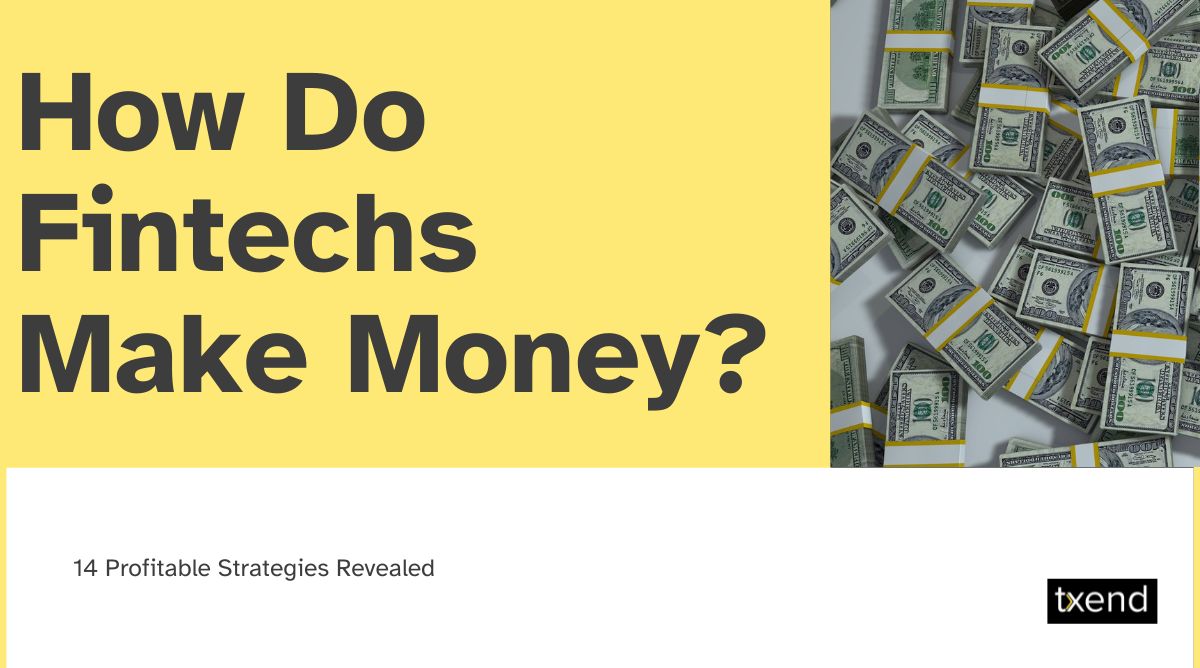How Do Fintechs Make Money?
Fintech firms, leading the charge in the dynamic realm of finance and technology, have spearheaded innovation, transforming money management and financial transactions.
These tech-savvy disruptors have not only changed the financial landscape but have also left many curious about a fundamental question: “How do fintechs make money?”
In this article, we will delve into the intricate workings of fintech business models, explore the various avenues of fintech monetization, and shed light on the secrets behind their financial success.
By the end of this journey, you’ll gain a comprehensive understanding of the strategies that power the revenue streams of fintech companies.

Fintech monetization refers to the strategies and methods that financial technology companies (fintechs) use to generate revenue from their products and services.
In the context of our article, “How Do Fintechs Make Money?” It’s a crucial aspect to explore.
Key Takeaways:
- Fintechs in the USA generate revenue through transaction fees, subscription models, lending, data monetization, and partnerships with traditional financial institutions.
- Fintech companies in the USA are reshaping revenue strategies through innovative fintech business models and expanding into neo banking services.
- Fintechs in the USA generate revenue through diverse strategies like transaction fees, subscription models, lending, data monetization, and strategic partnerships, ensuring profitability.
- Generating revenue in the US fintech industry involves transaction fees, subscription models, lending income, data monetization, partnerships, and diversified services.
How Fintechs Generate Revenue?
Fintech companies typically offer a wide range of financial services, from digital payments and lending to investment platforms and personal finance management tools.
To sustain and grow their operations, they need to find effective ways to turn these services into profitable ventures.
Fintech monetization strategies can vary, but some common approaches include:

Transaction Fees:
Fintech companies often charge fees for facilitating transactions.
For example, they may levy a small percentage on each payment processed.
Fintech ReDecoding venue Strategies:
The fintech business model is the blueprint or framework that fintech companies follow to create, deliver, and capture value in the financial technology industry.
It encompasses the strategies and approaches these companies use to generate revenue and sustain their operations.
Here are some key components and aspects of the fintech business model:
Service Offerings:
Fintech companies provide various financial services, such as digital payments, peer-to-peer lending, robo-advisory, crowdfunding, and more.
The specific services they offer are a fundamental aspect of their business model.
Customer Segmentation:
Fintech firms often target specific customer segments, such as consumers, small businesses, or even other financial institutions.
Recognizing the intended audience is essential for customizing services and marketing strategies effectively.
Revenue Streams:
Fintech companies generate revenue through multiple streams, which can include transaction fees, subscription models, licensing fees, and interest income.
The choice of revenue streams depends on the nature of the fintech’s services and its target market.
Technology Infrastructure:
Technology is at the heart of fintech operations.
Fintech firms invest in cutting-edge technology to develop and deliver their services efficiently.
This can include mobile apps, secure payment gateways, AI algorithms, and blockchain technology, among others.
Partnerships and Alliances:
Collaboration with traditional financial institutions or other fintech companies is a common strategy.
These partnerships can expand service offerings, reach a wider audience, and enhance the overall value proposition.
Regulatory Compliance:
Fintechs must navigate complex regulatory landscapes.
Their business model includes strategies for ensuring compliance with financial regulations and maintaining trust with customers.
User Experience:
Delivering a superb user experience constitutes an integral element of the fintech business model.
User-friendly interfaces, seamless transactions, and responsive customer support contribute to user satisfaction and loyalty.
14 Profitable Strategies Behind Fintech Revenue Generation

Subscription and Service Fees:
Fintech companies often charge customers regular subscription fees for premium services or access to their platforms.
These fees can vary in terms of pricing tiers and services offered.
Example: The popular budgeting app, YNAB (You Need A Budget), charges users a monthly or annual subscription fee for access to its financial planning and tracking tools.
Understanding Fintech Monetization:
Fintech monetization refers to the various strategies and methods employed by financial technology companies to generate revenue from their products and services.
Payment Processing and Funds Transfer Fees:
Fintechs often charge fees for processing payments and facilitating funds transfers, both for individuals and businesses.
These fees may be a flat rate or a percentage of the transaction amount.
Example: PayPal charges a fee for processing online payments and transferring funds between users.
Interchange Revenue:
Fintech firms can generate income via interchange fees, a portion of every transaction value that flows to the fintech when clients utilize their debit or credit cards.
Example: Square earns interchange fees when businesses process payments through its Square Point of Sale system.
Third-Party Partnerships:
Fintechs often collaborate with third-party companies, such as insurance providers or lenders, to offer additional financial products and services.
These partnerships can result in revenue-sharing agreements.
Example: Stripe partners with various financial institutions to offer Stripe Capital, providing business loans to its users.
Trading and Investment Fees:
Fintech platforms offering stock trading and investment services charge fees for executing trades and managing investments on behalf of users.
Example: Robinhood charges fees for premium services and offers a subscription plan called Robinhood Gold for advanced trading features.
Digital Insurance Premiums:
Some fintech companies offer digital insurance services and collect premiums from customers for coverage against various risks.
Example: Lemonade, an insurtech company, charges premiums for homeowners renters insurance through its digital platform.
Interest on Deposits:
Fintechs, particularly neobanks, can generate revenue by earning interest on customer deposits held in their accounts.
Example: Chime, a neobank, earns interest on the funds held in its customers’ Chime savings accounts.
Neo-Banking Services:
Neo-banks, often referred to as digital banks, create income by providing an extensive array of banking services, encompassing loans, debit cards, and savings accounts.
Example: Ally Bank, a digital bank, offers various financial products and services to its customers.
Crowdfunding Fees:
Fintech crowdfunding platforms charge fees for facilitating fundraising campaigns and connecting startups with potential investors.
Example: Kickstarter charges a fee on funds raised by crowdfunding campaigns hosted on its platform.
Robo-Advisor Fees:
Robo-advisory platforms charge fees for automated investment management and portfolio allocation services.
Example: Wealthfront charges an annual advisory fee for its robo-advisory services.
Advertising Revenue:
Fintech companies may generate income through advertising, promoting financial products, or displaying ads to their user base.
Example: Mint, a personal finance app, displays targeted financial product ads to its users.
Data Monetization:
Fintechs can monetize user data by selling insights and analytics to businesses or utilizing data for their own product development.
Example: Plaid, a fintech data aggregator, offers data analytics services to financial institutions and fintech companies.
API Licensing and Fees:
Explanat Fintechs often charge other businesses for access to their application programming interfaces (APIs), enabling third-party developers to integrate their services.
Example: PayPal offers various APIs for payment processing, and charges fees for API usage by developers and businesses.
These strategies demonstrate the diverse ways fintech companies in the USA generate revenue while providing innovative financial solutions and services.
Generating Revenue in the Fintech Industry: Practical Illustrations of Profit-Making Methods

Transaction Fees and Commissions:
Many fintechs rely on transaction fees and commissions as a primary source of income.
For instance, PayPal charges a fee when users receive payments for goods and services.
Similarly, stock trading apps like Robinhood make money by charging a small fee for executing trades.
Subscription Models:
Some fintechs offer premium services through subscription models.
A prime example is ‘Robinhood Gold,’ which provides advanced features and margin trading capabilities for a monthly fee.
This approach allows fintechs to monetize their user base effectively.
Lending and Interest Income:
Neo banks and peer-to-peer lending platforms generate revenue by offering loans and earning interest on them.
Take the case of LendingClub, which connects borrowers with investors.
LendingClub charges origination fees to borrowers and servicing fees to investors, thus profiting from both ends of the lending spectrum.
Data Analytics and Insights:
Fintechs often collect extensive data on user transactions and financial behavior.
They monetize this data by providing valuable insights to other businesses.
Plaid, for example, aggregates financial data and offers it to financial institutions and fintech apps, generating revenue through data access fees.
Cross-Selling and Upselling:
Many fintechs cross-sell or upsell financial products and services to their user base.
Wealthfront, a robo-advisory platform, offers a cash account with a higher interest rate, encouraging users to deposit more funds and, in turn, earn income from the spread between the interest paid to users and the interest earned on their deposits.
Partnerships and Collaborations:
Fintechs often collaborate with traditional financial institutions, earning referral fees or revenue-sharing agreements.
Square, for example, partners with various businesses and banks, earning a percentage of the payment processing fees and other financial services offered through their platform.
Crowdfunding and Fundraising:
Crowdfunding platforms like Kickstarter and Indiegogo charge fees for hosting campaigns and facilitating fundraising efforts.
They often earn a percentage of the total funds raised, providing a sustainable income stream.
Digital Wallets and Payment Processing:
Fintechs like Stripe and Square make money by providing businesses with the tools to accept online payments, earning a percentage of each transaction processed.
Digital wallets like Apple Pay may also charge fees to businesses for accepting payments through their platform.
Frequently Asked Questions
Fintech monetization isn’t exclusive to startups; established financial institutions also embrace fintech strategies to diversify and remain competitive.
Efficiency, accessibility, lower fees, personalized insights, and diverse financial offerings empower users to optimize their finances with fintech services.
Individuals, businesses, startups, investors, and underbanked populations can benefit from diverse fintech services, enhancing financial accessibility and efficiency.
Data fuels fintech monetization, guiding personalized services, risk assessment, insights, and targeted marketing while enhancing operational efficiency and innovation.
Yes, regulatory considerations are essential in fintech monetization.
Compliance with financial regulations ensures transparency, security, and fair practices in the industry.
Yes, diversification is crucial in fintech monetization.
It mitigates risks, ensures sustainable income, and adapts to evolving market dynamics.
Fintech companies generate revenue through transaction fees, subscriptions, lending interest, data monetization, cross-selling, partnerships, crowdfunding, and payment processing.
To stay ahead of fintech trends, regularly follow industry news, join fintech communities, attend conferences, and embrace digital financial tools.
Conclusion:
In conclusion as financial technology companies adeptly navigate the convergence of finance and technology to create a plethora of revenue streams.
Fintech monetization thrives on innovation, embracing transaction fees, subscription models, lending income, data monetization, cross-selling, strategic partnerships, crowdfunding, and payment processing.
These versatile strategies not only drive profitability but also adapt to the ever-changing landscape of financial services.
Amid this relentless innovation, it’s crucial to recognize that the primary keyword, “how do fintechs make money?” encapsulates the very essence of fintech’s dynamic nature.
Fintechs are not merely profit-driven; they are pioneers, catalysts for change, and enablers of financial accessibility, efficiency, and personalization.
Their success is intertwined with the transformation of traditional finance, making them instrumental in shaping the financial landscape of the future.



